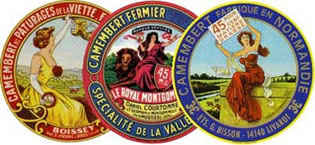Camembert Cheese

- SUBSCRIBE
- ALREADY SUBSCRIBED?
BECOME A BONJOUR PARIS MEMBER
Gain full access to our collection of over 5,000 articles and bring the City of Light into your life. Just 60 USD per year.
Find out why you should become a member here.
Sign in
Fill in your credentials below.
by Madelyn Byrne Paris Apartments at www.parisperfect.com
 Camembert is a beloved favorite of ours because my husband Philippe comes from Normandy, where it is produced. This famous cheese was invented in 1791 by a woman farmer in the Normandy town of Camembert who received tips and advice from a heretical priest from Brie, who was hiding from his pursuers in her house. French soldiers were issued Camembert cheese when they went off to fight in World War I, something that struck soldiers from other nations as incredibly funny. And Camembert inspired Salvador Dali in his painting, The Persistence of Memory, where the watches ‘melt’ on the canvas, resembling over-ripe Camembert.
Camembert is a beloved favorite of ours because my husband Philippe comes from Normandy, where it is produced. This famous cheese was invented in 1791 by a woman farmer in the Normandy town of Camembert who received tips and advice from a heretical priest from Brie, who was hiding from his pursuers in her house. French soldiers were issued Camembert cheese when they went off to fight in World War I, something that struck soldiers from other nations as incredibly funny. And Camembert inspired Salvador Dali in his painting, The Persistence of Memory, where the watches ‘melt’ on the canvas, resembling over-ripe Camembert.
Normandy is famous for its green pastures that contribute to the incredibly rich flavor of the cheese, the fat content of which must be at least 45%. Made with raw milk that is curdled carefully for 1.5 hours with the enzyme rennet, it is then carefully ladled into the molds according to regulations that include making precisely four passes over each mold with a special ladle. During this hours-long process, the milk cannot rise above 98.6 degrees F. The next day, the Camembert is taken out of the mold and covered with a thin layer of special salt. Finally, ‘penicillium candidum’ fungus is applied and the aging process begins. As the official Camembert documentation states, the Camembert is ripe 30 to 35 days after its birth.
Camembert is known for its soft, fuzzy shell, which leaves pale striations in the cheese, and for its wonderful soft and silky texture inside. The French have an expression called ‘fait’ which means that the cheese is just ripe. When Camembert is fait, you will find that it runs out of its soft shell onto the plate…perfect! To select their Camembert, most French squeeze each cheese to test its ripeness. For today’s consumption, you should be able to feel the softness of the cheese. They call this ‘une puce Normand’ or a Norman thumb. In cheese shops, the server will do this for you – don’t do it yourself unless given permission. Simply tell them which day you wish to eat it and voila: you take home a perfect accompaniment to a glass of wine!
The traditional container for this cheese is a round wooden box. When you are in France, buy a special Camembert container – a round clear plastic box with a special tab to hold the runny cheese inside its shell.
Enjoying Camembert
The French say that Camembert is better in the spring, when the cows have better quality pasturage and therefore produce better milk.
Store your cheese in the refrigerator and take it out several hours before eating to bring out the flavor. When we were newly married, I made the mistake of freezing some leftover Camembert and later putting it in the microwave to defrost and serve at a dinner party. It was the texture of soft rubber. Quelle horreur! Philippe was horrified. The microwave killed the texture and taste. We learned that it is fine to freeze camembert but always to let it defrost normally.
The taste is strong and the French advise you to drink it with a young red wine with little tannin – not a great wine which may become overwhelmed. A good red Bourgueil or even a cider from the Pays d’Auge is excellent. Recently, we followed some of our good friend’s advice and started to drink white wine with our cheese course and that is excellent, too.
I came across this tidbit from the Camembert.com site: ‘The camembert can hardly be considered as a “light” product even if you taste it with moderation (and that would be a pity). Nevertheless many sacrifice their waistline for the pleasure of tasting that beautiful flavor. On the other hand, one should remember that the camembert also contains many of the elements that are needed for the child growth. So there you have several perfect excuses for eating as much as you like.’
AOC: How to distinguish the best French products.
A special blue and yellow label is applied to the top cheeses, wines and butters in France, called the Appellation d’Origine Contrôlée (AOC), a certification granted by the French Government to certain products.
It all began in the 15th century with Roquefort cheese, which was regulated by parliamentary decree. This special protection moved from cheeses to wines and even to butter. The label protects the producers from other regions counterfeiting their fine products. You will find the AOC on many wines as well, distinguishing a defined geographic origin and production process.
AOC cheeses – there are only 45 of them – must be made with milk from cows of that specific region and must be produced in that specific climate and geography. Strict criteria must be followed in order to maintain the AOC’s standards and the ‘savoir faire’ of making the cheeses is passed from generation to generation. When you shop, look for the small blue and yellow AOC label to be assured of the best quality.


